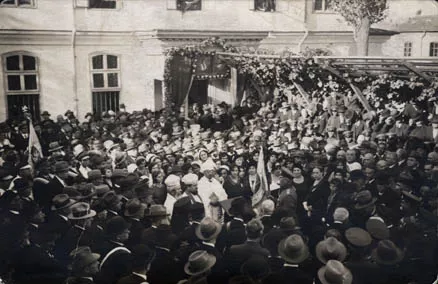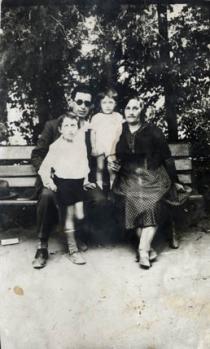The [Sephardi] synagogue in Ruse during an unknown holiday in 1933.
There were two synagogues in Ruse -one of them was owned by the Sephardi Jews. It was big and beautiful. The other one was owned by the Ashkenazi Jews. There were two or three religious officials in the Sephardi synagogue and one chazzan in the Ashkenazi one. The rabbi is something like the bishop. He is more of a teacher than a preacher. There was also a shochet and a slaughter house at the synagogue. We brought there hens and chickens. Around 50 000 people lived in Ruse at that time. The Jewish community was around 3 000 people. There was a Jewish primary school. I graduated that school and so did most of the Jewish children. The school was a one-floor house in the Jewish neighborhood. Besides the big synagogue in Ruse there was a smaller one - midrash. The Ashkenazi synagogue is nowadays a club of the Shalom organization. After 9th September 1944 [the day of the communist takeover in Bulgaria] and the emigration of the Jews it was turned into a gym. The walls of the old synagogue are more or less one meter thick. There was one enormous chandelier brought probably from Austria. I do not know if the synagogue is working now, because it is in a decrepit state. The smaller synagogue was demolished when the street to the river was constructed before 1944. The club of the lobby 'Bnai Brith' was next to that synagogue. Weddings, balls and parties were organized there because there was a big hall. It was a very elegant house and opposite it there was another big house, whose first floor was taken by the organization 'Malbish Arumim' (meaning 'dressing the poor') [Jewish women's charity organisation. It was registered in 1912 in Ruse and in 1920 in Sofia.] On Sundays the merchants went there to play cards and mingle. The chazzan was also a shochet. There was a small brick building in the yard of the old Jewish school. There were hooks on its wall from which the birds slaughtered by the shochet for the Yom Kippur holiday were hung. That school was demolished in 1940-41 after the earthquake in Vrancha, Romania [Vrancha is an area in the Carpathian Mountains in Romania, famous as an area of strong seismic activity. Here earthquakes take place in 8-14 years, with an epicenter 100 km deep, which determines the great length of the seismic wave. The greatest earthquake in Vrancha was recorded in 1940 and has a magnitude of 9.5 on the Richter scale. The next big earthquake is in 1977 and has a magnitude of 7.2, in 1986 - 7.00 and in 1990 - 7.2] and we were not allowed to access the buildings of the Hashomer Hatzair organization. There was also a canteen for poor children in the yard. The Jewish school was with 20-25 children in each class and a junior high school - four years of primary school and three years of junior high school. Most of the Jewish children first studied in the Jewish school and then in a Bulgarian high school or technical school. We also studied religious subjects. We studied Jewish literature, Jewish history and Jewish religion - Tannakh. On Friday evenings we were taken to the synagogue and the older students read the prayer. My brother Mois was one of the chazzans there when he was in the third grade. He is still religious and goes to the synagogue. He read the prayers and tried to follow the prescriptions.
At that time there was a variety of Jewish professions. There were rich merchants, street vendors, craftsmen, porters, factory owner such as Avram Ventura. He owned the 'Zhiti' factory, which manufactured bolts, rivets and nails. There were also Jewish workers, but there was also that very nice organization of the Jewish community 'Malbish Arumim', which raised money from the rich and gave breakfast and lunch to the poor children in the Jewish school. It was founded by the Jewish municipality. In the autumn they also bought clothes and shoes for the poor Jewish children. At that time we did not feel anti-Semitism towards us. We were very tolerant to each other. We always took part in the parades and national holidays.
My brother and I took part in the sports organisation 'Maccabi'. On all holidays we went out in uniforms, carrying a drum and a flag. We were part of the parade as were all people in Ruse. We sang various songs - 'Maritsa Rushes', 'Quiet White Danube' - the songs all sang. Of the Jewish songs we knew about Trumpeldor. In fact, we were educated in Zionism. That was done by a Jewish nationalistic organization. There were a number of Zionist organizations - 'General Zionists', 'Poalei Zion', 'Revisionists of Jabotinsky' and youth organizations such as 'Hashomer Hatzair' and 'Maccabi'. 'Maccabi' was a sports organization. We had a very nice gym where we gathered daily and twice a week we did exercises with a gym instructor. My father was in the leadership of 'General Zionists', which was a centrist organization. The other one, 'Poalei Zion' was a leftist, social democratic organization, and the Revisionists founded by Jabotinsky (a Polish Jew) had a right orientation and were more radical about the liberation of Palestine. Each organization had its youth formations. The Revisionists had 'Betar' - they organized manifestations in the Jewish neighborhood dressed in brown shirts and black trousers. The others were 'Hashomer Hatzair' - they studied hard Ivrit and in the organization 'Ken' (nest) they spoke only in Ivrit and were getting ready for an aliyah (leaving) for Israel - to work in the kibbutzim there. And 'Maccabi' was also a Zionist sports organization - follower of the 'General Zionists'.
Apart from education, every family received the so-called steel money-boxes used to collect donations. They were called 'Keren Kayemet le'Israel' - these were money to buy land in Palestine. These money-boxes were regularly taken to the municipality, all the money was collected and sent to the Consistory. Thus, the first Jewish settlements in Israel were created - the Israeli lands were bought from the Arabs and the kibbutzim and villages were built.





























